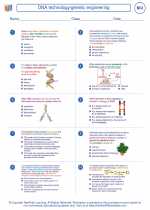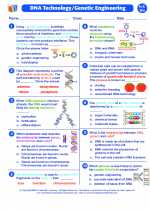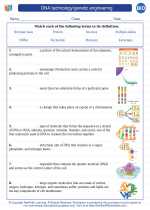DNA: The Molecule of Life
DNA, or deoxyribonucleic acid, is a molecule that carries the genetic instructions for the development, functioning, growth, and reproduction of all known living organisms and many viruses. It is often referred to as the "molecule of life" because of its crucial role in heredity and genetics.
Structure of DNA
DNA is a long polymer made up of repeating units called nucleotides. Each nucleotide consists of a sugar molecule (deoxyribose), a phosphate group, and a nitrogenous base. There are four types of nitrogenous bases in DNA: adenine (A), thymine (T), cytosine (C), and guanine (G). The structure of DNA is often described as a double helix, resembling a twisted ladder, with the sugar-phosphate backbones forming the sides and the paired nitrogenous bases forming the rungs of the ladder.
Functions of DNA
1. Genetic Information Storage: DNA carries the genetic information that determines an organism's traits and characteristics. It serves as a blueprint for the synthesis of proteins and the regulation of various cellular activities.
2. Replication: DNA can make copies of itself through a process called DNA replication, ensuring that genetic information is passed on to new cells during cell division.
3. Protein Synthesis: DNA provides the instructions for synthesizing proteins through a process called gene expression. This involves the transcription of DNA into messenger RNA (mRNA) and the subsequent translation of mRNA into specific amino acids, which are the building blocks of proteins.
Study Guide
Here are some key concepts and questions to help you understand and study DNA:
- Describe the structure of a DNA molecule, including the components of a nucleotide and the arrangement of nitrogenous bases.
- Explain the significance of DNA as the carrier of genetic information in living organisms.
- Discuss the process of DNA replication and its importance in inheritance and cell division.
- Describe the central dogma of molecular biology and how DNA serves as the template for protein synthesis.
- Explore the role of DNA in heredity, genetic variation, and evolutionary processes.
By understanding the structure and functions of DNA, you will gain insights into the fundamental basis of life and genetics, as well as the mechanisms that drive biological diversity and inheritance.
[Dna] Related Worksheets and Study Guides:
.◂Biology Worksheets and Study Guides High School. DNA technology/genetic engineering

 Worksheet/Answer key
Worksheet/Answer key
 Worksheet/Answer key
Worksheet/Answer key
 Worksheet/Answer key
Worksheet/Answer key
 Vocabulary/Answer key
Vocabulary/Answer key
 Vocabulary/Answer key
Vocabulary/Answer key
 Vocabulary/Answer key
Vocabulary/Answer key
